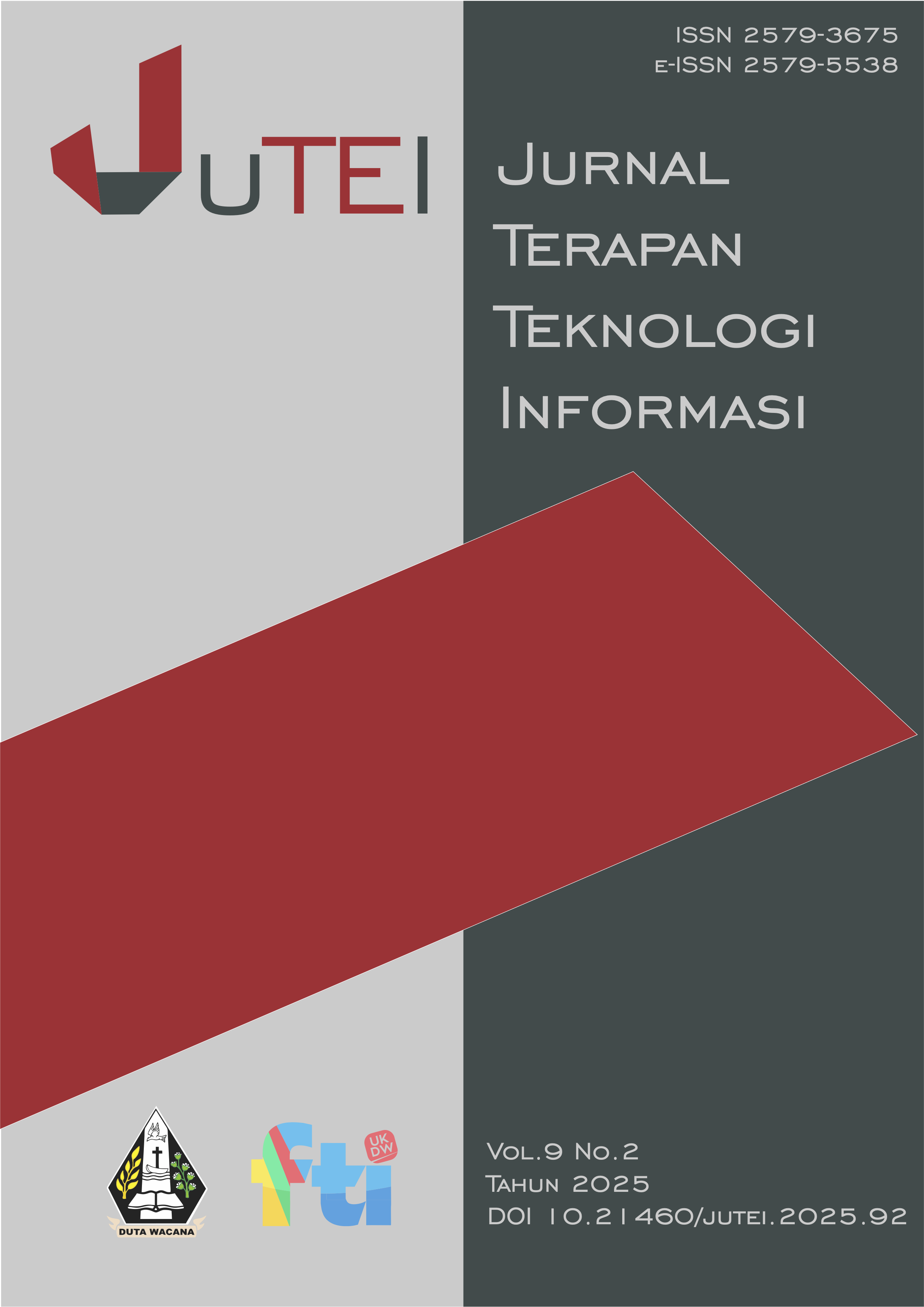Implementation of Rasa Framework To Build FAQ Bot System As Bureau Information Service 3
DOI:
https://doi.org/10.21460/jutei.2025.92.431Keywords:
FAQ Bot, RASA Open Source, TelegramAbstract
Duta Wacana Christian University (UKDW), specifically Bureau 3 (BIRO 3), provides a variety of information services accessible through both online channels, such as Instagram, WhatsApp, and email, and offline methods. However, BIRO 3 has not yet implemented an FAQ Bot system, which means that frequently asked questions are still answered manually. This practice renders the question-and-answer process regarding campus information repetitive and time-consuming. This research aims to implement the RASA Open Source framework to develop an FAQ Bot system to automate the retrieval of information for frequently asked questions at BIRO 3, thereby enhancing the efficiency of its information services.
The system was developed using RASA Open Source and implemented on the Telegram messaging platform. The evaluation was conducted through a two-fold approach. First, internal testing of the RASA model on the validation dataset yielded optimal results, achieving accuracy, precision, and F1-scores of 1.000. On the test data, the model demonstrated strong performance with an accuracy of 0.915, a precision of 0.928, and an F1-score of 0.912. Second, functional testing was performed by engaging users in predefined scenarios. This second phase of testing resulted in a functional accuracy of 95% based on 200 collected data points.
The user testing results indicate that the FAQ Bot system was successfully developed and capable of achieving a functional accuracy rate of 95%. Despite its high performance, limitations were identified in the form of eleven false positive and false negative cases out of the 200 data points. This suggests that the model has not yet perfectly learned to comprehend all variations of user input. Therefore, recommendations such as expanding the training dataset and exploring modifications to the RASA Open Source framework are proposed to refine the system's capabilities, enabling it to handle all types of inquiries accurately.
References
AMINI, H., FARAHNAK, F., & KOSSEIM, L. (2019). FRONTIERS IN PATTERN RECOGNITION AND ARTIFICIAL INTELLIGENCE. IN H. AMINI, F. FARAHNAK, & L. KOSSEIM, FRONTIERS IN PATTERN RECOGNITION AND ARTIFICIAL INTELLIGENCE (PP. 35-55). MONTREAL: WORLD SCIENTIFIC.
Aziz, S. N., Nathasia, N. D., & Hassolthine, C. R. (2024). Pembuatan aplikasi chatbot faq untuk motionbank. Journal of Information System, Applied, Management, Accounting and Research, 118-127.
Azizah, A. N., Asy'ari, M. F., Prasatya, I. W., & Purwitasari, D. (2023). EASY DATA AUGMENTATION UNTUK DATA YANG IMBALANCE PADA KONSULTASI KESEHATAN DARING. Jurnal Teknologi Informasi dan Ilmu Komputer (JTIIK) , 1095-1104.
Bocklisch, T., Faulkner, J., Pawlowski, N., & Nichol, A. (2017). Rasa: Open source language understanding and dialogue management. arXiv preprint arXiv:1712.05181, 1-9.
Caballero, M. (2021). A BRIEF SURVEY OF QUESTION. International Journal of Artificial Intelligence & Applications , 1-7.
Guntoro, Costaner, L., & Lisnawita. (2020). Aplikasi Chatbot untuk Layanan Informasi dan Akademik Kampus Berbasis Artificial Intelligence Markup Language (AIML). Digital Zone: Jurnal Teknologi Informasi Dan Komunikasi, 291-300.
Hien, H. T., Nguyen, C. P., Hoai, N. N., & Nhung, H. T. (2018). Intelligent Assistants in Higher-Education Environments: The FITEBot, a Chatbot for Administrative and Learning Support. SoICT’ 18: Ninth International Symposium on Information and Communication Technology (pp. 1-8). Viet Nam: Association for Computing Machinery.
Hikmah, N., Ariyanti, D., & Pratama, F. A. (2022). Implementasi Chatbot Sebagai Virtual Assistant di Universitas Panca Marga Probolinggo menggunakan Metode TF-IDF. Jurnal Teknologi Informasi dan Multimedia, 133-148.
Ingale, N., Jha, T. A., Dixit, R., & Borate, V. K. (2020). College Enquiry Chatbot Using Rasa. International Journal of Scientific Research in Science and Technology, 210-215.
Kurniawati, Y. E. (2024, October 31). Model Evaluation Metrics untuk Machine Learning. Retrieved from Sis Binus: https://sis.binus.ac.id/2024/10/31/model-evaluation-metrics-untuk-machine-learning/
Mangotra, H., Dabas, V., Khetharpal, B., Verma, A., Shinghal, S., & Mohapatra, A. K. (2024). University Auto Reply FAQ Chatbot Using NLP and Neural Networks. Artificial Intelligence and Applications, 126–134.
Nugroho, K. S. (2019, November 13). Confusion Matrix untuk Evaluasi Model pada Supervised Learning. Retrieved from Medium: https://ksnugroho.medium.com/confusion-matrix-untuk-evaluasi-model-pada-unsupervised-machine-learning-bc4b1ae9ae3f
Pratama, S. D., Lasimin, & Dadaprawira, M. N. (2023). Pengujian Black Box Testing Pada Aplikasi Edu Digital Berbasis Website Menggunakan Metode Equivalence Dan Boundary Value. Jurnal Teknologi Sistem Informasi dan Sistem Komputer TGD, 560-569.
Raniloya, B. R., Raghuwanshi, N., & Singh, S. (2017). Chatbot for University Related FAQs. International Conference on Advances in Computing, Communications and Informatics (ICACCI) (pp. 1525-1530). Udupi: IEEE.
Senington, R., Pataki, B., & Wang, X. V. (2018). Using docker for factory system software management: Experience report. procedia CIRp, 659–664.
Sethi, F. (2020). FAQ (Frequently Asked Questions) ChatBot for Conversation. International Journal of Computer Sciences and Engineering , 1.
Sigdel, Y., Shrestha, S., & Neupane, N. (2024). College Chatbot Using RASA. KEC Journal of Science and Engineering, 39-43.
Vdb, M. (2025, 4 25). Components. Retrieved from Rasa: https://legacy-docs-oss.rasa.com/docs/rasa/components
Vdb, M. (2025, 4 25). Model Configuration. Retrieved from Rasa: https://legacy-docs-oss.rasa.com/docs/rasa/model-configuration
Vdb, M. (2025, 4 25). Policies. Retrieved from Rasa: https://legacy-docs-oss.rasa.com/docs/rasa/policies
Vdb, M. (2025, 4 25). Rasa Glossary. Retrieved from Rasa: https://legacy-docs-oss.rasa.com/docs/rasa/glossary
Vdb, M. (2025, 4 25). Telegram. Retrieved from Rasa: https://legacy-docs-oss.rasa.com/docs/rasa/connectors/telegram
Vdb, M. (2025, 4 25). Training Data Format. Retrieved from Rasa: https://legacy-docs-oss.rasa.com/docs/rasa/training-data-format
Widya, M. A., & Airlangga, P. (2020). PENGEMBANGAN TELEGRAM BOT ENGINE MENGGUNAKAN METODE WEBHOOK DALAM PENINGKATAN WAKTU LAYANAN E-GOVERNMENT. SAINTEKBU, 13-22.
Downloads
Published
How to Cite
Issue
Section
License
Copyright (c) 2025 Rivai Talenggoran, Lucia D. Krisnawati, Gloria Virginia

This work is licensed under a Creative Commons Attribution-NonCommercial-NoDerivatives 4.0 International License.
Authors who publish articles in JUTEI agree on the following rules:
1. The author grants non exclusive royalty free rights, and is willing to publish articles online and complete (full access). With such rights JUTEI reserves the right to save, transfers, manages in various forms, maintains and publishes articles while keeping the author's name as the copyright owner.
2. Each author contained in the article has contributed fully to the substance and intellectual, and is accountable to the public. If in the future there is a copyright infringement notification then this will be responsibility of the author, not JUTEI.







